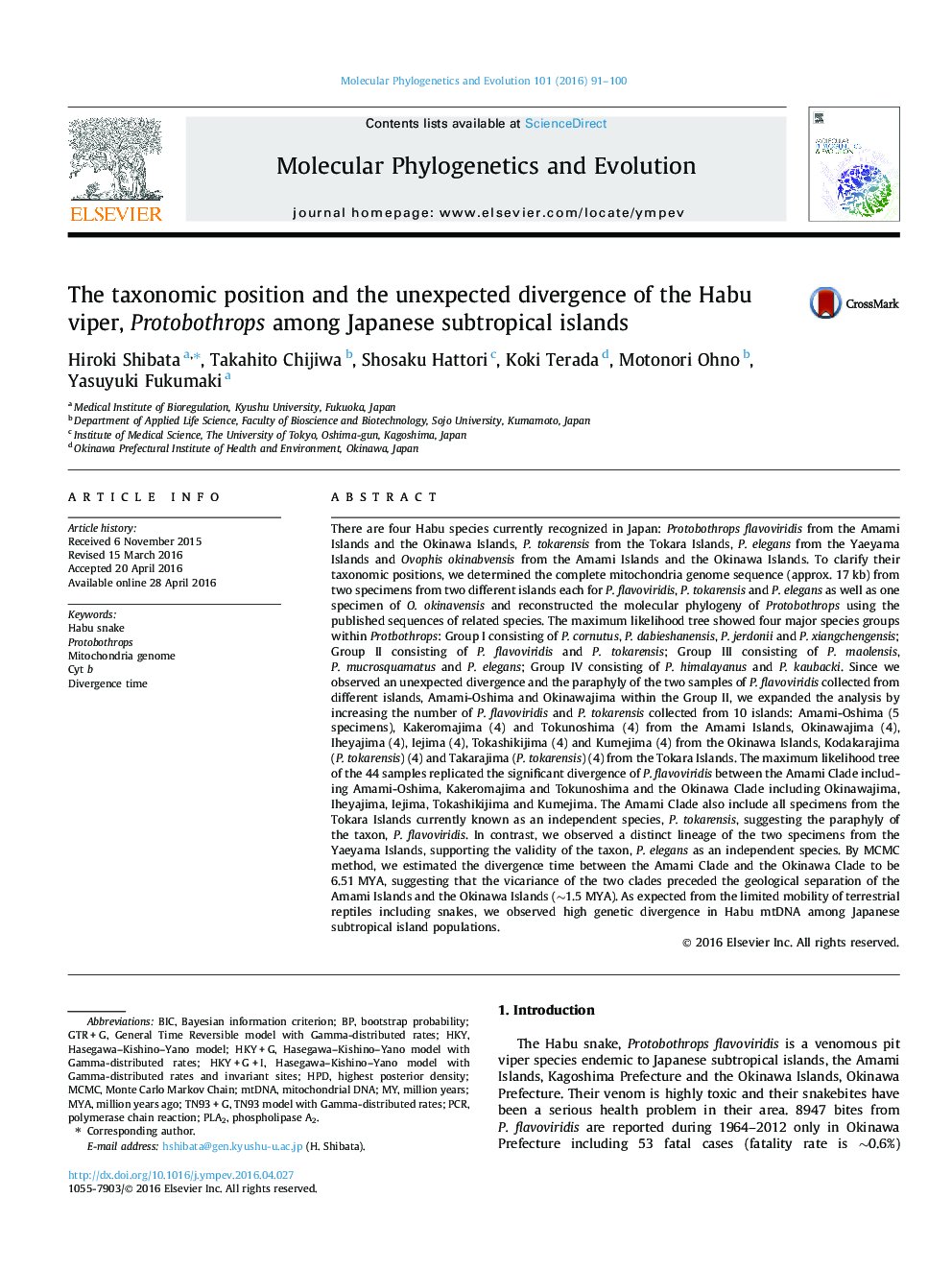| کد مقاله | کد نشریه | سال انتشار | مقاله انگلیسی | نسخه تمام متن |
|---|---|---|---|---|
| 5918405 | 1570796 | 2016 | 10 صفحه PDF | دانلود رایگان |

- Determined the complete mtDNA sequence of 43 specimens of Protobothrops collected from 12 Japanese subtropical islands.
- P. flavoviridis and P. tokarensis form a distinct species group in the phylogeny of 12 Protobothrops species.
- Observed a significant genetic divergence of P. flavoviridis between the Amami Clade and the Okinawa Clade.
- All specimen of P. tokarensis are included in the Amami Cluster, suggesting the paraphyly of P. flavoviridis.
- The divergence time of the two clusters, 6.5Â MYA, vastly precedes the geological vicariance of the islands, 1.5Â MYA.
There are four Habu species currently recognized in Japan: Protobothrops flavoviridis from the Amami Islands and the Okinawa Islands, P. tokarensis from the Tokara Islands, P. elegans from the Yaeyama Islands and Ovophis okinabvensis from the Amami Islands and the Okinawa Islands. To clarify their taxonomic positions, we determined the complete mitochondria genome sequence (approx. 17Â kb) from two specimens from two different islands each for P. flavoviridis, P. tokarensis and P. elegans as well as one specimen of O. okinavensis and reconstructed the molecular phylogeny of Protobothrops using the published sequences of related species. The maximum likelihood tree showed four major species groups within Protbothrops: Group I consisting of P. cornutus, P. dabieshanensis, P. jerdonii and P. xiangchengensis; Group II consisting of P. flavoviridis and P. tokarensis; Group III consisting of P. maolensis, P. mucrosquamatus and P. elegans; Group IV consisting of P. himalayanus and P. kaubacki. Since we observed an unexpected divergence and the paraphyly of the two samples of P. flavoviridis collected from different islands, Amami-Oshima and Okinawajima within the Group II, we expanded the analysis by increasing the number of P. flavoviridis and P. tokarensis collected from 10 islands: Amami-Oshima (5 specimens), Kakeromajima (4) and Tokunoshima (4) from the Amami Islands, Okinawajima (4), Iheyajima (4), Iejima (4), Tokashikijima (4) and Kumejima (4) from the Okinawa Islands, Kodakarajima (P. tokarensis) (4) and Takarajima (P. tokarensis) (4) from the Tokara Islands. The maximum likelihood tree of the 44 samples replicated the significant divergence of P. flavoviridis between the Amami Clade including Amami-Oshima, Kakeromajima and Tokunoshima and the Okinawa Clade including Okinawajima, Iheyajima, Iejima, Tokashikijima and Kumejima. The Amami Clade also include all specimens from the Tokara Islands currently known as an independent species, P. tokarensis, suggesting the paraphyly of the taxon, P. flavoviridis. In contrast, we observed a distinct lineage of the two specimens from the Yaeyama Islands, supporting the validity of the taxon, P. elegans as an independent species. By MCMC method, we estimated the divergence time between the Amami Clade and the Okinawa Clade to be 6.51Â MYA, suggesting that the vicariance of the two clades preceded the geological separation of the Amami Islands and the Okinawa Islands (â¼1.5Â MYA). As expected from the limited mobility of terrestrial reptiles including snakes, we observed high genetic divergence in Habu mtDNA among Japanese subtropical island populations.
223
Journal: Molecular Phylogenetics and Evolution - Volume 101, August 2016, Pages 91-100